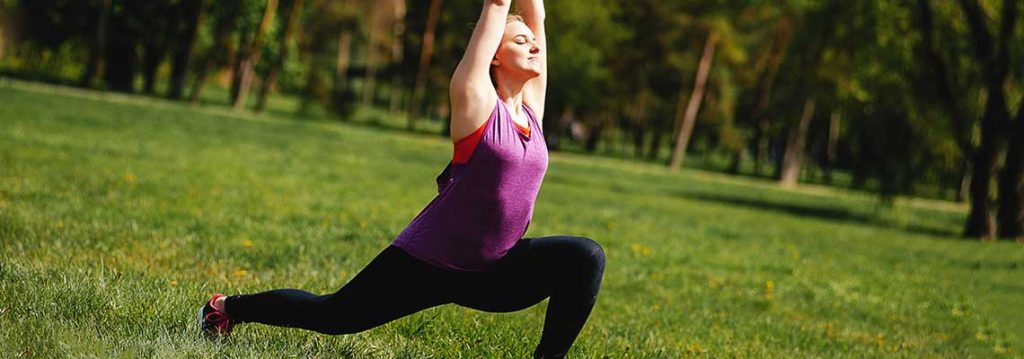
Guest author: Brittany Noonan
Pregnancy is tough work both physically and mentally! I’m not going to lie: Before I fell pregnant, I actually never appreciated what a woman’s body goes through during pregnancy. You are constantly nauseated, tired, your body aches, your boobs ache, you get back pain, headaches and your hormones are all over the place—which can make you a crazy person—plus you end up with a heavy watermelon sized bump stuck to the front of you. Obviously this is not a full list of pregnancy problems, but we would be here all day if I kept going and of course, in the end, it’s all worth it when you get to hold your perfect little bubba in your arms for the first time.
In this blog, I want to talk about how we can strengthen our bodies in preparation for pregnancy and if you’re able, these exercises can continue safely during pregnancy and beyond.
I’m sorry it’s a super long post, but I needed to get all these important tips in so please take the time to read, especially if you’re pregnant or thinking about having a baby.
If you are strong and fit before pregnancy, you can continue to stay active and strong all the way through to child birth and postpartum (unless medical circumstances do not allow). Before doing any form of exercise during pregnancy or if you are planning pregnancy please consult your GP, OB and physio to gain medical clearance.
Strengthening Your Back
It’s pretty obvious that your back is going to take a lot of extra stress during pregnancy as your center of gravity shifts and your spine needs to carry all that extra weight in the front. Not only is it important to strengthen and protect your lower back, but it is also just as important to strengthen your upper back muscles. As pregnancy goes on, our boobs grow, change and become heavy. This causes our chest and shoulders to tighten and slump so we need to keep get our upper back strong enough to support this and keep a nice straight posture. This will also help with avoiding tension headaches.
Back Strengthening Exercises:
Upper Back:
Lat Pulldown: Narrow grip, high cable pulldowns, pull ups (assisted or not) and seated row.
Lower Back:
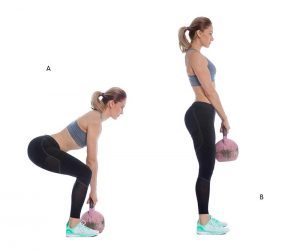 Deadlift: Kettlebell, dumbbell or barbell, bent over row, wide grip lat pulldown and one arm row.
Deadlift: Kettlebell, dumbbell or barbell, bent over row, wide grip lat pulldown and one arm row.
During pregnancy or if you are planning pregnancy and strengthening your body, the need to train your chest is very little. I would recommend only doing one chest exercise for every three back exercises to avoid extra tightness and discomfort.
Strengthening and Stretching Your Hips
During pregnancy, our bodies release a hormone called “Relaxin.” This hormone helps us to push out our baby during child birth but also causes hip pain during pregnancy. Unfortunately, there is no way of preventing this but if your hips are strong but not tight before pregnancy and if you stay active, strong and stretched during pregnancy you can reduce the pain.
Please remember that hip exercises using weight are generally only safe during your first and second trimester. As you get bigger your hips become more stressed and unstable.
Hip Strengthening Exercises:
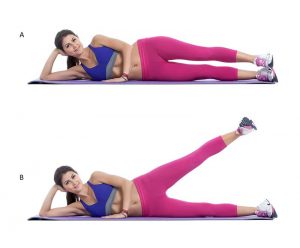 Cycling: Only recommended before or during early pregnancy due to the instability of being on the bike.
Cycling: Only recommended before or during early pregnancy due to the instability of being on the bike.
Swimming: Particularly breaststroke (as you do not need to twist your spine) is an excellent way to strengthen your hips before and during pregnancy with no impact but is also safer as there is no imbalance like cycling.
Standing side leg raises: Using ankle weights, cables or body weight.
Lying side leg raises/pulses: Using ankle weights or body weight.
Abductor/adductor machine
Hip Stretches:
Cat/cow: Back arches and curls on hands and knees.
 Butterfly stretch: Seated with soles of feet together, bend your knees up into a butterfly position-gently push down on your knees with your elbows while holding on to your feet (never hold your ankles during this stretch). Hold for a minimum of 30 seconds.
Butterfly stretch: Seated with soles of feet together, bend your knees up into a butterfly position-gently push down on your knees with your elbows while holding on to your feet (never hold your ankles during this stretch). Hold for a minimum of 30 seconds.
Hip flexor stretch: Step one leg out in front and lunge down, straighten back leg, push heel to floor while pushing out the hip on the same side until you feel a stretch through your flexor, hold for a minimum of 30 seconds before swapping legs.
Strengthening and Protecting Your Pelvic Floor
You have probably heard a lot about the importance of strengthening your pelvic floor while pregnant. The perfect time to start is before you even fall pregnant.
You might be wondering what exactly it is? Your pelvic floor is the layers of muscles that stretch across the front of your pubic bone and help to keep your bladder closed. These muscles can become stretched and weak through the pressure of pregnancy and child birth.
There’s a lot I could talk about when it comes to protecting your pelvic floor but I will save that for an entirely separate blog.
The best way to increase pelvic floor strength is by doing Kegels (pelvic floor squeezes).
Some tips to get these right:
Imagine you’re trying to stop yourself from peeing mid-stream.
Pull up, squeeze and lift without sucking in your tummy.
Make sure you don’t squeeze your butt or your legs together.
Do some quick ones and some that you hold for three to five seconds whenever you think of it throughout the day and night!
It is just as important to protect your pelvic floor as it is to strengthen it so as you get a bigger belly or start to feel pressure (feeling like you are going to pee) I would suggest restricting exercise with impact such as running, skipping, plyometrics (jumping movements) and heavy lifting.
Post pregnancy it is very important that we continue to protect our pelvic floor as it has weakened and needs time to heal.
Some tips to help protect your pelvic floor after:
Avoid heavy lifting
Avoid sit-ups and straight leg raises
Avoid impact exercise including running, skipping and plyometrics for the first six months
Listen to your body and don’t continue with any type of exercise or movement that you do not feel comfortable with or makes you feel like you need to pee!
Abs and Core
The best time to strengthen your core is definitely before you fall pregnant. The best thing about having a strong core when you are pregnant is that it will help support your back, reducing back pain and can help to support the weight of your growing tummy.
Before you are pregnant, smash out any core exercises you can think of but once pregnant and post pregnancy (minimum of six months or until your separation has healed) there’s definitely some movements you should avoid and some you should continue to avoid any extra separation of the abdominal wall and causing permanent damage that could require surgery:
AVOID:
Sit-ups
Crunches
Twisting movements (Russia twists, bicycle crunches etc.)
Only do planks on your toes if you already have a very strong core
Leg raises
CONTINUE:
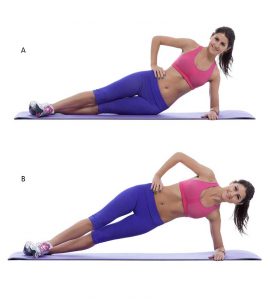 Reach and curl
Reach and curl
Planks on your knees
Side planks (only if you’re strong enough)
Pelvic tilts on a swiss ball
Kegels
Toe taps
Not only will having a strong core help you during pregnancy but it will actually also help with child birth and speed up your recovery.
The above is generalized information. Once again I stress: If you are pregnant, planning to become pregnant or have recently had a baby please consult your doctor or OB before commencing ANY type of physical activity even if you are strong, healthy and fit. If you are post-partum it is recommended to wait at least six weeks and gain medical clearance before returning to exercise.
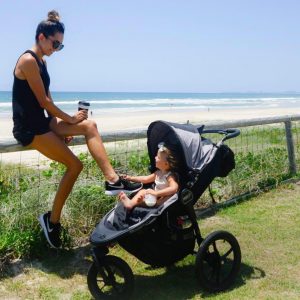
Brittany Noonan is a wife and proud mom to one girl. She is a fitness trainer and runs the blog bybrittanynoonan, a motherhood, fitness and style blog for moms and moms-to-be.


